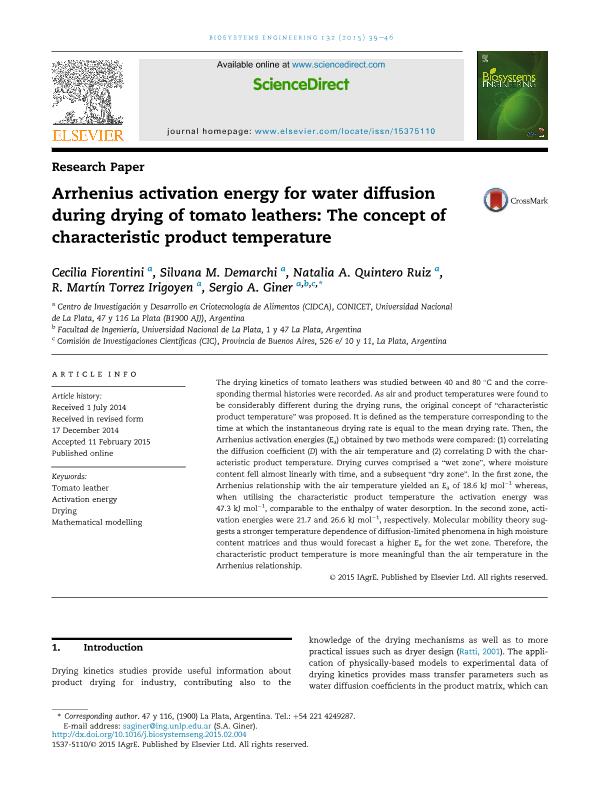Mostrar el registro sencillo del ítem
dc.contributor.author
Fiorentini, Cecilia
dc.contributor.author
Demarchi, Silvana María

dc.contributor.author
Quintero Ruiz, Natalia Andrea

dc.contributor.author
Torrez Irigoyen, Ricardo Martin

dc.contributor.author
Giner, Sergio Adrian

dc.date.available
2018-03-08T19:37:06Z
dc.date.issued
2015-04
dc.identifier.citation
Fiorentini, Cecilia; Demarchi, Silvana María; Quintero Ruiz, Natalia Andrea; Torrez Irigoyen, Ricardo Martin; Giner, Sergio Adrian; Arrhenius activation energy for water diffusion during drying of tomato leathers: The concept of characteristic product temperature; Academic Press Inc Elsevier Science; Biosystems Engineering; 132; 4-2015; 39-46
dc.identifier.issn
1537-5110
dc.identifier.uri
http://hdl.handle.net/11336/38294
dc.description.abstract
The drying kinetics of tomato leathers was studied between 40 and 80°C and the corresponding thermal histories were recorded. As air and product temperatures were found to be considerably different during the drying runs, the original concept of "characteristic product temperature" was proposed. It is defined as the temperature corresponding to the time at which the instantaneous drying rate is equal to the mean drying rate. Then, the Arrhenius activation energies (Ea) obtained by two methods were compared: (1) correlating the diffusion coefficient (D) with the air temperature and (2) correlating D with the characteristic product temperature. Drying curves comprised a "wet zone", where moisture content fell almost linearly with time, and a subsequent "dry zone". In the first zone, the Arrhenius relationship with the air temperature yielded an Ea of 18.6kJmol-1 whereas, when utilising the characteristic product temperature the activation energy was 47.3kJmol-1, comparable to the enthalpy of water desorption. In the second zone, activation energies were 21.7 and 26.6kJmol-1, respectively. Molecular mobility theory suggests a stronger temperature dependence of diffusion-limited phenomena in high moisture content matrices and thus would forecast a higher Ea for the wet zone. Therefore, the characteristic product temperature is more meaningful than the air temperature in the Arrhenius relationship.
dc.format
application/pdf
dc.language.iso
eng
dc.publisher
Academic Press Inc Elsevier Science

dc.rights
info:eu-repo/semantics/openAccess
dc.rights.uri
https://creativecommons.org/licenses/by-nc-nd/2.5/ar/
dc.subject
Activation Energy
dc.subject
Drying
dc.subject
Mathematical Modelling
dc.subject
Tomato Leather
dc.subject.classification
Alimentos y Bebidas

dc.subject.classification
Otras Ingenierías y Tecnologías

dc.subject.classification
INGENIERÍAS Y TECNOLOGÍAS

dc.title
Arrhenius activation energy for water diffusion during drying of tomato leathers: The concept of characteristic product temperature
dc.type
info:eu-repo/semantics/article
dc.type
info:ar-repo/semantics/artículo
dc.type
info:eu-repo/semantics/publishedVersion
dc.date.updated
2018-03-06T17:45:31Z
dc.journal.volume
132
dc.journal.pagination
39-46
dc.journal.pais
Estados Unidos

dc.description.fil
Fil: Fiorentini, Cecilia. Provincia de Buenos Aires. Gobernación. Comisión de Investigaciones Científicas. Centro de Investigación y Desarrollo en Criotecnología de Alimentos. Consejo Nacional de Investigaciones Científicas y Técnicas. Centro Científico Tecnológico Conicet - La Plata. Centro de Investigación y Desarrollo en Criotecnología de Alimentos. Universidad Nacional de La Plata. Facultad de Ciencias Exactas. Centro de Investigación y Desarrollo en Criotecnología de Alimentos; Argentina
dc.description.fil
Fil: Demarchi, Silvana María. Provincia de Buenos Aires. Gobernación. Comisión de Investigaciones Científicas. Centro de Investigación y Desarrollo en Criotecnología de Alimentos. Consejo Nacional de Investigaciones Científicas y Técnicas. Centro Científico Tecnológico Conicet - La Plata. Centro de Investigación y Desarrollo en Criotecnología de Alimentos. Universidad Nacional de La Plata. Facultad de Ciencias Exactas. Centro de Investigación y Desarrollo en Criotecnología de Alimentos; Argentina
dc.description.fil
Fil: Quintero Ruiz, Natalia Andrea. Provincia de Buenos Aires. Gobernación. Comisión de Investigaciones Científicas. Centro de Investigación y Desarrollo en Criotecnología de Alimentos. Consejo Nacional de Investigaciones Científicas y Técnicas. Centro Científico Tecnológico Conicet - La Plata. Centro de Investigación y Desarrollo en Criotecnología de Alimentos. Universidad Nacional de La Plata. Facultad de Ciencias Exactas. Centro de Investigación y Desarrollo en Criotecnología de Alimentos; Argentina
dc.description.fil
Fil: Torrez Irigoyen, Ricardo Martin. Provincia de Buenos Aires. Gobernación. Comisión de Investigaciones Científicas. Centro de Investigación y Desarrollo en Criotecnología de Alimentos. Consejo Nacional de Investigaciones Científicas y Técnicas. Centro Científico Tecnológico Conicet - La Plata. Centro de Investigación y Desarrollo en Criotecnología de Alimentos. Universidad Nacional de La Plata. Facultad de Ciencias Exactas. Centro de Investigación y Desarrollo en Criotecnología de Alimentos; Argentina
dc.description.fil
Fil: Giner, Sergio Adrian. Provincia de Buenos Aires. Gobernación. Comisión de Investigaciones Científicas. Centro de Investigación y Desarrollo en Criotecnología de Alimentos. Consejo Nacional de Investigaciones Científicas y Técnicas. Centro Científico Tecnológico Conicet - La Plata. Centro de Investigación y Desarrollo en Criotecnología de Alimentos. Universidad Nacional de La Plata. Facultad de Ciencias Exactas. Centro de Investigación y Desarrollo en Criotecnología de Alimentos; Argentina
dc.journal.title
Biosystems Engineering

dc.relation.alternativeid
info:eu-repo/semantics/altIdentifier/url/http://www.sciencedirect.com/science/article/pii/S1537511015000239
dc.relation.alternativeid
info:eu-repo/semantics/altIdentifier/doi/http://dx.doi.org/10.1016/j.biosystemseng.2015.02.004
Archivos asociados
